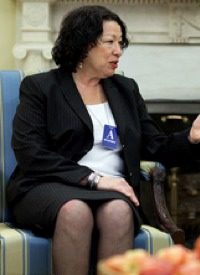
The ruling in Ricci et al. v DeStefano et al. (pdf) would appear to add to the statistical challenge the nominee will likely face at her confirmation hearings before the Senate Judiciary Committee. Sotomayor has been overturned by the U.S. Supreme Court on 60 percent of her appealed rulings. Those with long memories may recall that Nixon nominee G. Harold Carswell, rejected by the Senate in 1970, was considered “mediocre” by many of the senators because he had been overturned on 58 percent of the appeals of his decisions.
Judge Jose A. Cabranes, writing for himself and five other judges, dissented from the appeals court decision, noting that the panel’s ruling “contains no reference whatsoever to the constitutional claims at the core of this case” and added that “this perfunctory disposition rests uneasily with the weighty issues presented by this appeal.”
That assessment may carry added weight with senators who are considering the Sotomayor nomination, since Judge Cabranes, far from being an adversary of the nominee, has been her mentor and was chosen by her to administer the judicial oath to her twice — in 1992 after President George H.W. Bush had appointed her to the U.S. District Court in Manhattan and again in 1998 when she was President Bill Clinton’s appointee to the Second Circuit Court of Appeals.
The affirmative action issue and charges of “reverse racism” may cause trouble for Sotomayor with some members of the committee. The case and the dissenting judge’s pointed criticism call into question Sotomayor’s devotion to constitutional principles and raises the troubling question of whether racial, gender and “identity politics” might have a greater influence on her judgment than the statutes and the constitutional provisions being adjudicated.
On the other hand, Senator Patrick Leahy (D-Vt.), chairman of the Judiciary Committee, argued that the closeness of the vote indicates that Judge Sotomayor’s ruling was not that far from the reasoning of the current Supreme Court. “It is notable that four justices would have upheld the Second Circuit’s ruling,” said Leahy, who seemed to be arguing that it is the Supreme Court and not the lower appeals court that decided the case wrongly. “It is less likely now that employers will conscientiously try to fulfill their obligations under this time-honored civil rights law,” he said.
But Justice Anthony Kennedy, writing the majority opinion for the closely divided court, said it was the city of New Haven that violated the Civil Rights Act of 1964 by discriminating against the successful applicants on the basis of race. “Whatever the city’s ultimate aim — however well intentioned or benevolent it might have seemed — the city made its employment decision because of race,” Kennedy wrote. “The city rejected the test results solely because the higher scoring applicants were white.”
The 1964 law, a divisive issue in that year’s presidential campaign, forbids discrimination in employment and public accommodations that is based on race, religion, and national origin. Its proponents at the time of its passage, most notably Sen. Hubert H. Humphrey of Minnesota, argued that it would not be used to promote “reverse discrimination,” but was intended to forbid discrimination against members of racial or ethnic majorities as well as minorities.
Nonetheless, U.S. Sen. Barry M. Goldwater of Arizona, that year’s Republican nominee for president, voted against the bill, arguing that it was an unconstitutional intrusion of federal authority into activities the Constitution left to the states or the people. Though President John F. Kennedy proposed the law in June of 1963, just months before his assassination, and his successor, Lyndon Johnson, pushed for its passage, it was supported by a majority of Republicans and a minority of Democrats in Congress. Many of the Democrats, who then held a narrow majority in each house, were from the then solidly Democratic South and did not look kindly on anti-segregation legislation. Goldwater, while losing in a landslide nationally, carried five Southern states along with his home state of Arizona in that year’s election, breaking the Democratic stranglehold on the South and leading to a “Southern strategy” for the Republicans that helped the GOP win seven of the next 10 presidential elections.
Kennedy, a Reagan appointee who is often a swing vote on a court closely divided between its conservative and liberal blocs, was joined in the majority by Chief Justice John Roberts and Associate Justice Samuel Alito, both appointees of George W. Bush. Reagan appointee Antonin Scalia and Clarence Thomas, appointed in 1991 by President George H.W. Bush, also sided with the firefighters’ appeal. Voting to uphold the decision of Sotomayor and the majority of her colleagues on the Second Circuit Court of Appeals were Clinton appointees Ruth Bader Ginsburg and Stephen Breyer, John Paul Stephens, appointed by the late President Gerald Ford, and David Souter, an appointee of the first President Bush and the justice Sotomayor has been chosen to succeed on the high court.
“Firefighting is a profession in which the legacy of racial discrimination casts an especially long shadow,” wrote Justice Ginsburg in dissent. “I would hold that New Haven had ample cause to believe its selection process was flawed and not justified by business necessity.”
Sotomayor, born and raised in the Bronx, New York, is of Puerto Rico parentage and is the first Latin-American nominated for the U.S. Supreme Court. That fact may make it awkward for Senate Republicans to oppose her nomination, since Republicans have often sought and have had some success in attracting Hispanic and Latino votes. On the other hand, one of the plaintiffs in the New Haven lawsuit, Ben Vargas, is an Hispanic-American firefighter, a point surely not to be missed in the confirmation hearings.
Also at issue will be the judge’s controversial statement, made on a number of occasions, that a Latina would make a better judicial decision than a “wise old white man.” So will her statement at a Duke Law School seminar that “the Court of Appeals is where policy is made.” Though she was quick to add, “We don’t make law,” she appeared at the same time to be joining in the laughter from the audience at that disclaimer.
Sotomayor will no doubt be asked as well about her six years as a member of the national council of La Raza (“The Race”), an Hispanic organization that not only advocates open borders and amnesty for illegal aliens, but has also called for the return of four Southwestern states and parts of two others to Mexico.
The confirmation hearing by the Senate Judiciary Committee is scheduled to begin on Monday, July 13.



